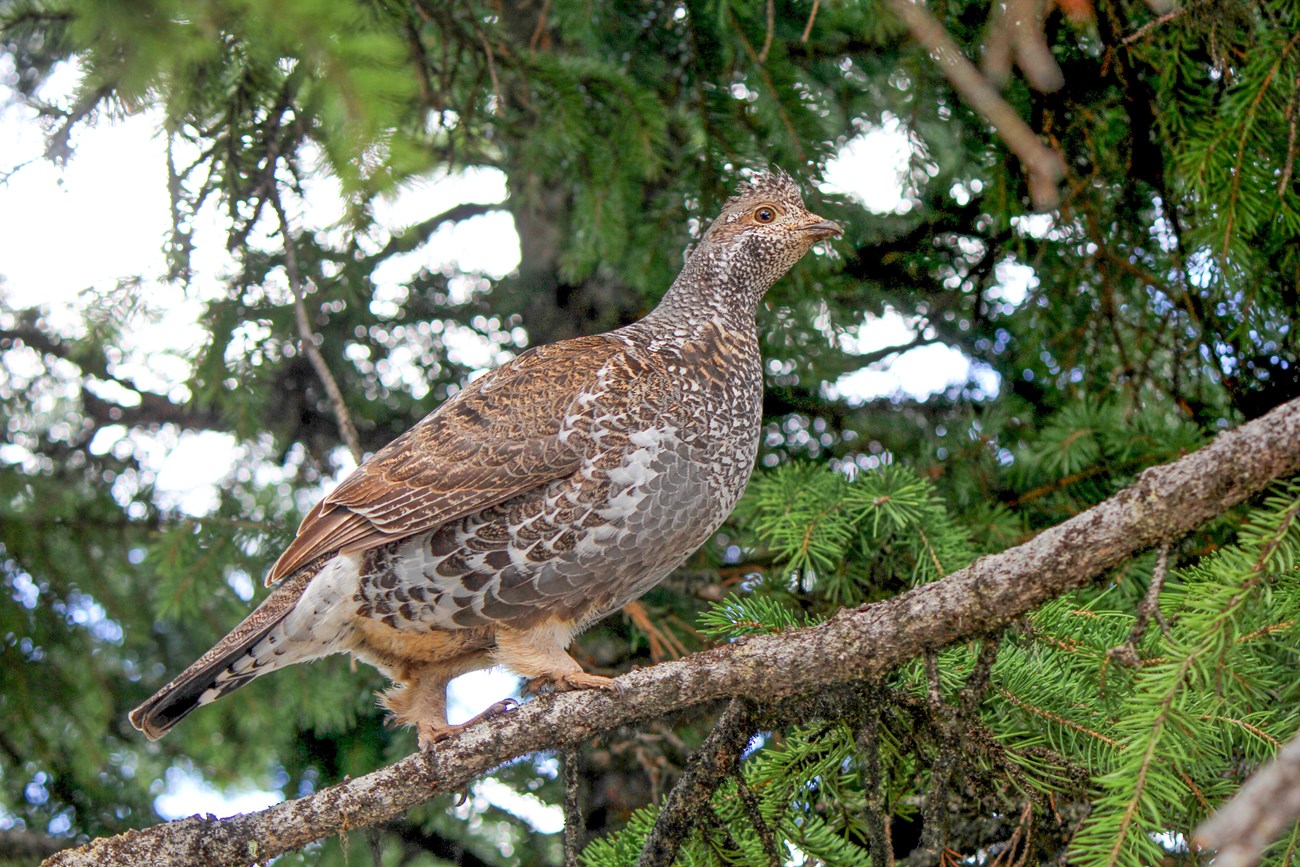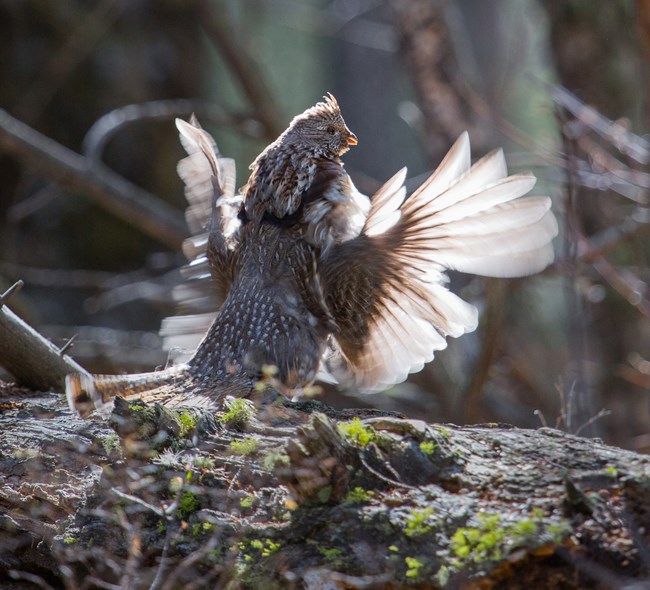Last updated: November 25, 2020
Article
Ruffed Grouse

NPS/Eric Johnston
General Description
While snow and cold drive many Pacific Northwest birds south for the winter, the hardy ruffed grouse (Bonasa umbellus) can be found year-round in its woodland habitat. This medium-sized member of the family Phasianidae, which includes pheasants, quail, partridges, and turkeys, has a chunky body (43–50 cm (17–20 in) long) that is well-camouflaged by reddish-brown to gray streaking and mottling. Its head feathers form a crest and its tail ends in a distinct dark band. More prominent in males, a dark, glossy tuft of neck feathers can be raised into a collar-like ruff—hence the name, “ruffed" grouse. Feathered leg bones (tarsi) help it weather the cold. The only look-alike in southern Oregon and northern California is the female sooty grouse (Dendragapus fuliginosus), which is larger and lacks both the head crest and the dark tail band of the ruffed grouse.
Habitat and Distribution
The ruffed grouse lives in North American deciduous and coniferous forest, coast to coast, from Alaska and Canada south partway into the lower 48 Unites States, including western Washington, western Oregon, and the northwestern corner of California. They are most abundant in younger forest, where denser understories provide escape cover but are not so thick as to be impenetrable. Across the grouse’s range, aspen (Populus spp.) woodlands are especially important for the food their flower buds provide. In western Oregon and northern California, these grouse often use streamside thickets and younger mixed woodlands at lower to mid elevations.
Diet
Ruffed grouse eat a wide variety of plant material, with a small dose of insects thrown in. The summer diet includes leaves, fruits, berries, and seeds, while in winter ruffed grouse turn to twigs, as well as flower buds and catkins. Their unusually long cecum may play a role in digesting this high-fiber diet. Acorns are a rich source of energy in the fall.

NPS/Neal Herbert
Behavior
While ruffed grouse are capable of primitive vocalizations, such as squeals, hissing, and chirps, they are better known for a different kind of sound. In the mornings and evenings, especially as breeding begins in the spring, ruffed grouse can be heard “drumming.” Perched securely on an elevated spot, like a log or boulder, the male braces its tail and rapidly beats its wings back and forth to create an accelerating series of thump-like sounds. Miniature sonic booms create these sounds as air rushes into the sudden vacuum created by fast wingbeats. Drumming serves to guard territory and attract mates, and can be heard year-round, though most often during breeding. Breeding season also triggers males to strut around with ruff and tail spread open, hissing and shaking their heads.
In areas with sufficient winter snowfall, these grouse have a clever trick for staying warm. They actually dive or dig their way underneath the snow and roost in the relatively warmer tunnel below the surface. Approaching footsteps can cause the grouse to explode out of the snow in front of a very startled human.
Reproduction
In April, males attract females to their small territories for a very brief pair bond during copulation. Within a week, the female builds a small, bowl-shaped nest on the ground from leaves and other plant material. The nest cup is about 16 cm (6 in) wide and typically placed at the base of a tree, stump or boulder. Ruffed grouse often nest in deciduous forest that is open enough at ground level for a view of approaching predators. The female lays 9 to 14 eggs and incubates them for a little over 3 weeks. The newly hatched chicks are precocial, capable of walking, finding food, and avoiding predators within a few hours. They remain with the hen for their first 3 months before dispersing in the fall. Females begin breeding the next spring as yearlings.
Relationship with Humans
Ruffed grouse are a popular game bird, hunted throughout their range, including in the Pacific Northwest. Populations are currently stable, although Audubon climate models predict a northward shift in their range almost entirely out of the continental U.S. under the warmest climate scenarios.
Fun Facts
- Some call this bird a “thunder chicken,” in honor of its drumming display.
- Each fall, ruffed grouse grow fringes (pectinations) along the sides of their toes to extend the surface area of their feet, like snowshoes. They drop them in the spring.
Where to See
Ruffed grouse occur in most of the Klamath Network parks. It is probably present at Lassen Volcanic NP and absent from Whiskeytown NRA.Learn More
Hear a ruffed grouse drumming:
Download a pdf of this article.
Prepared by Sonya Daw
NPS Klamath Inventory & Monitoring Network
Southern Oregon University
1250 Siskiyou Blvd
Ashland, OR 97520
Featured Creature Edition: November 2020
Thumbnail image credit: Eric Johnston
